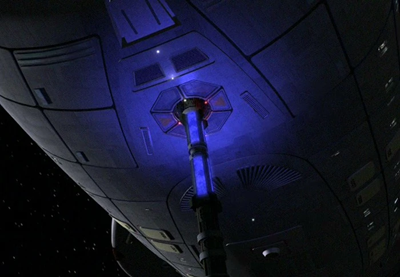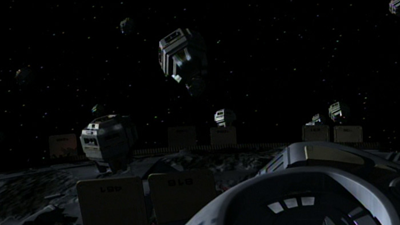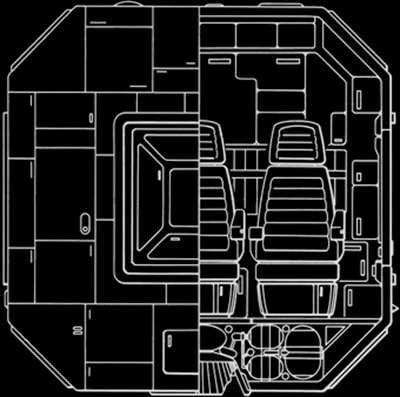Emergency Operations
Created by Commodore Wilkan Targaryen on Sat Dec 21st, 2024 @ 1:20pm
Emergency Medical Operations
 The Century Class Starship has been specifically designed to provide assistance to planetary populations, starbases, and other starships that are experiencing emergency situations impacting their populace. Often, these incidents require the direct intervention and support of the Enterprise's Medical Teams to be resolved. While the Enterprise has a significantly large Medical Team that are capable of responding to routine medical issues with the ship's crew, the care responsibilities in an emergency can be overwhelming. Yet, the crew are prepared to intervene as needed.
The Century Class Starship has been specifically designed to provide assistance to planetary populations, starbases, and other starships that are experiencing emergency situations impacting their populace. Often, these incidents require the direct intervention and support of the Enterprise's Medical Teams to be resolved. While the Enterprise has a significantly large Medical Team that are capable of responding to routine medical issues with the ship's crew, the care responsibilities in an emergency can be overwhelming. Yet, the crew are prepared to intervene as needed. Under Starfleet Regulations at least 40% of the officers and crew of the century Class are cross-trained to assist with Medical services in an emergency. During any significant Medical emergency these personnel are mobilized to assist the Medical Team. Depending upon the size of the survivor population, one or more of the Enterprise's Cargo and Shuttlebays may be converted into field hospitals and housing for the evacuees. The Holodecks are also suitably equipped and include provisions to allow the environmental systems to temporarily match a Class H, K, or L environment. If needed unoccupied cabins can also be converted into treatment areas. As the activation of the field hospitals can impact shuttle operations, Cargobays and Holodecks are typically converted prior to the Shuttle Bay.
During any emergency situation the Medical Team will use standard triage protocols in the treatment of any injured survivors. Upon arrival at the incident site, personnel will categorize patients based upon their survivability. If a patient is severely injured, but treatable, they will be prioritized and treated before persons with minimal injuries. In periods of war Starfleet will implement battlefield triage protocols and patients with minimal injuries would be prioritized. Patients who are beyond help will not be assisted in order to conserve resources as energy availability for replication may be limited and on had supplies may quickly dwindle. Rarely will the Chief Medical Officer opt to initiate treatment options at the site of the incident, but it is not out of the realm of possibility if there are a large number of patients.
Fire Suppression
 Due to the complexities of space travel the risks of fire aboard a starship are immeasurable. Under Starfleet Regulations each and every component part of a Starfleet vessel must meet strict standards of inflammability. Despite these protocols, fires can still occur as the result of enemy attack, system malfunctions, or related situations. To defend the vessel from such instances each Federation starship is equipped with a Fire Suppression Systems.
Due to the complexities of space travel the risks of fire aboard a starship are immeasurable. Under Starfleet Regulations each and every component part of a Starfleet vessel must meet strict standards of inflammability. Despite these protocols, fires can still occur as the result of enemy attack, system malfunctions, or related situations. To defend the vessel from such instances each Federation starship is equipped with a Fire Suppression Systems. Each Internal Sensor Pallet includes dedicated fire detection hardware as part of the security suite. In the event that a fire is detected the computer immediately notifies Engineering, Operations, and Security personnel of the incident. If the fire is easily contained the Fire Suppression System will engage a containment forcefield to isolate the fire from the rest of the ship, restricting environmental controls in the area to remove oxygen and other atmospheric gases from the vicinity of the fire. Specialized chemicals could be released to assist in extinguishing the fire, or a Fire Control Team deployed to fight the fire as well. Once the fire is extinguished and the sensors rule out the potential for the fire to rekindle, the forcefield will release. If the fire is large the Fire Suppression System will seal of the area and engage specialized isolation doors to attempt to contain the fire to one area of the ship. Containment fields engage and atmospheric controls modified to cut oxygen to the fire. In most conditions this will work to extinguish the fire; however, should this process fail, the computer will vent the entire area into space to protect the rest of the ship.
Propulsion System Emergency Ejection Procedures
Antimatter Pod Ejection
Powered by a controlled annihilation of Matter and Antimatter, the Warp Core of a Federation Starship is an incredibly powerful piece of equipment; however, it's also a very dangerous technology if any component part of it were to become unstable. One of the most dangerous incidents that can occur is the loss of Antimatter Storage Pod Containment as any breach of the Antimatter system can result in the immediate destruction of the starship. Engineering Safety Protocols include multiple processes that can be attempted to stabilize the system, but the Antimatter Storage Pods can be ejected as a final act to protect the ship and crew.Closely monitored by the Internal Sensors and highly automated, the Main Computer will immediately notify the Bridge and Main Engineering should it detect any breach, or potential breach, of the Antimatter Storage system. Personnel will attempt to stabilize the system, but will engage the ejection system as a last-ditch effort to protect the ship. Directed by either the vessel's Commanding Officer, Executive Officer, or the Chief Engineering Officer, Antimatter Storage Pod Ejection involved the ejection of the entire storage assembly. Exterior hatches are released and miniature explosive charged detonated to propel the assembly into space. The Enterprise crew will analyze the Antimatter Storage Assembly once they have reached minimum safe distance to determine whether the system can be recovered. Should the assembly be salvageable a team will be deployed to recover the unit and main repairs before reintegration. If the assembly is not retrievable the crew will construct a replacement and install to resume normal operations.
Impulse Fusion Reactor Ejection
The Impulse Propulsion System allows the Enterprise to travel at slower-than-light speeds and uses Fusion Reactors to generate thrust that moves the ship. While not as powerful as the Warp Core, the Fusion Reactors produce incredible amounts of energy and can be very dangerous should they become unstable. Engineering Safety Protocols include multiple processes that can be attempted to stabilize the system, such as cutting fuel venting energy, or shutting down the engine. If these processes fail it is possible to eject the Fusion Reactors.Similar to ejecting the Warp Core, Fusion Reactor Ejection is directed by either the Commanding Officer, Executive Officer, or Chief Engineer of the Enterprise. Personnel will evacuate from Impulse Engineering and external pressure doors leading to the Fusion Reactors will release. Internal components and low-powered explosive ordinance packages will detonate to push the Impulse Fusion Reactor into space.
Once the Reactor has been safely ejected, Enterprise will travel to a safe distance from the Fusion Reactor. If the Reactor detonates the crew will call for assistance or attempt to fabricate a replacement from component parts in storage. If the Impulse Reactor stabilizes the crew will begin recovery efforts. Once the Fusion Reactor is recovered (or rebuilt) it is installed, and the ship resumes normal operations.
Warp Core Ejection
 Powered by a controlled annihilation of Matter and Antimatter, the Warp Core of a Federation Starship is an incredibly powerful piece of equipment; however, it's also a very dangerous technology if it were to become unstable. Engineering Safety Protocols include multiple processes that can be attempted to stabilize the system, such as cutting fuel to the Warp Core, activating a containment field, or decoupling the Dilithium Matrix. Should these procedures fail, the final option available to protect the ship and crew is to eject the vessel's Warp Core.
Powered by a controlled annihilation of Matter and Antimatter, the Warp Core of a Federation Starship is an incredibly powerful piece of equipment; however, it's also a very dangerous technology if it were to become unstable. Engineering Safety Protocols include multiple processes that can be attempted to stabilize the system, such as cutting fuel to the Warp Core, activating a containment field, or decoupling the Dilithium Matrix. Should these procedures fail, the final option available to protect the ship and crew is to eject the vessel's Warp Core.The process to eject the Warp Core begins with the evacuation of the Engine Room and the deployment of safety bulkheads to isolate the Warp Core from the rest of the ship. Manual release or verbal commands are then issued by either the vessel's Commanding Officer, Executive Officer, or the Chief Engineering Officer to eject the Warp Core. The Main Computer verifies the identity of this officer by a combination of genetic scan and voiceprint to ensure appropriate authorization and then initializes the ejection procedure. External pressure doors leading to the Warp Core are opened and the computer begins to severe the connective pylons securing the Core into its housing by detonating low powered explosive charges. The Warp Core is then ejected into space.
Once the Warp Core has been safely ejected the Enterprise will extricate itself from the area at Impulse speeds, monitoring the Warp Core's status via the ship's sensors as it travels. Should the Warp Core detonate the crew will call for assistance or attempt to fabricate a replacement Warp Core from component parts in storage aboard the vessel. If the Warp Core stabilizes and cools, the crew will begin efforts to recover the Warp Core and reinstall it using a shuttlecraft. Once the Warp Core is recovered (or rebuilt) it is installed, and the ship resumes normal operations.
The same process is utilized to eject the Quantum Slipstream Burst Drive Core from the Chevron Section.
Warp Nacelle Ejection
Powered by a controlled annihilation of Matter and Antimatter, the Warp Core of a Federation Starship is an incredibly powerful piece of equipment; however, it's also a very dangerous technology if it were to become unstable. While a Warp Core Breach is a dangerous emergency impacting shipboard operations, similar failures within the Plasma Injection System or to the Warp Nacelle are just as devastating to the Enterprise and its operations. Because of the risks to the Enterprise's survivability, Engineering Safety Protocols include a process to eject the Warp Nacelles from the Enterprise's hull.Engaged after other protocols are implemented (including shutting down the Warp Core or venting plasma from the Nacelles), Warp Nacelle ejection beings with either manual release or verbal commands from the vessel's Commanding Officer, Executive Officer, or the Chief Engineering Officer. The Main Computer verifies the identity of this officer and orders evacuation of the Nacelle Control Room, therein initializing the ejection procedure. Explosive charges within the Nacelle Pylon detonate, releasing the Nacelle into space.
Once the Enterprise is at minimum safe distance, crew will implement procedures to recover the damaged Nacelle and effect repairs. Despite the complex nature of the Nacelle structure, the Engineering Teams aboard the Century Class have been trained in the reintegration of the exterior Nacelles, releasing the ship from the requirement of traveling to a Starbase for support. Unlike the Warp Core, however, the ship cannot rebuild the Warp Nacelle if it is destroyed and must replace the unit at a Shipyard. Should the Nacelle be recovered and reintegrated the ship will resume normal operations.
Rescue and Evacuation Procedures
Evacuation from the U.S.S. Enterprise
 In situations where the Enterprise herself is at risk of destruction, Starfleet Protocols place the safety of the ship's crew and passengers at the highest priority (unless evacuation actions would violate the Prime Directive). Because of the importance of their efforts to save as many as possible, Enterprise has been equipped with multiple life sustaining systems that can be used to evacuate personnel in an untenable situation.
In situations where the Enterprise herself is at risk of destruction, Starfleet Protocols place the safety of the ship's crew and passengers at the highest priority (unless evacuation actions would violate the Prime Directive). Because of the importance of their efforts to save as many as possible, Enterprise has been equipped with multiple life sustaining systems that can be used to evacuate personnel in an untenable situation. When the order to abandon ship has been given, the first option explored is to employ separated flight mode and to use the more stable section of the vessel as its own lifeboat. If this is not possible, alternative protocols are engaged to evacuate the ship through the use of the Enterprise's Escape Pods. The Escape Pods are small craft that are used in a similar way to the lifeboats of Old Earth's seagoing vessels to evacuate crew and passengers from a sinking ship. If the vessel is near to a habitable planet or another vessel, personnel could be evacuated by Transporter as well as by Runabout or Shuttlecraft to the nearest habitable location or vessel to request help.
Once abandoned, all personnel will move to a minimum safe distance from the Enterprise in order to protect themselves from the potential detonation of the vessel's Warp Core. If the Enterprise can potentially be saved, however, appropriate Damage Control Teams may stay behind in an effort to recover the ship before it is destroyed.
Escape Pods
 While Starfleet vessels are designed to survive even the most brutal of engagements, they are not indestructible. If a starship is at risk of being destroyed or must be abandoned for some reason the ship's company can evacuate the ship via Escape Pods. Located throughout the ship, Escape Pods are small autonomous vehicles designed to help their passengers to survive the destruction of their vessel. Unarmed and undefended, Escape Pods are a designed for short-term use until their passengers can be rescued.
While Starfleet vessels are designed to survive even the most brutal of engagements, they are not indestructible. If a starship is at risk of being destroyed or must be abandoned for some reason the ship's company can evacuate the ship via Escape Pods. Located throughout the ship, Escape Pods are small autonomous vehicles designed to help their passengers to survive the destruction of their vessel. Unarmed and undefended, Escape Pods are a designed for short-term use until their passengers can be rescued. Capable of evacuating eight survivors, immediately following launch an automated distress call is transmitted from the Escape Pod's Subspace Radio, identifying the vehicle's location and number of survivors. Each Escape Pod contains life-support and supplies for 90 days of continuous usage and survival gear. Outfitted with Impulse Thrusters for maneuvering, Escape Pods may remain in open space or, as atmosphere capable craft, may choose to land on a suitable planet's surface. While they do have these Impulse Thrusters their available energy is limited but may be supplemented by connecting with other Escape Pods to share resources and supplies amongst each other. Should the survivors choose to land on a planetary surface they must disengage their connections with the other vessels.
Evacuation to the U.S.S. Enterprise
 One of the primary objectives of the Starship Enterprise is to respond to calls for help from those it encounters during its travels, whether it be a planetary or spaceborne emergency. Often during any rescue scenario the Enterprise is called upon to transfer survivors aboard the starship to ensure their safety.
One of the primary objectives of the Starship Enterprise is to respond to calls for help from those it encounters during its travels, whether it be a planetary or spaceborne emergency. Often during any rescue scenario the Enterprise is called upon to transfer survivors aboard the starship to ensure their safety. Century Class Starships are designed with emergency response in mind and several procedures exist to maximize the vessel's resources during a rescue scenario. While not as large as an Odyssey Class vessel, the Enterprise is capable of supporting as many as 13,000 people during an emergency through the conversion of the Cargo and Shuttlebays and other areas into emergency housing spaces, with some of these areas also being setup as medical treatment centers. Evacuees can be transported aboard the ship through the usage of the ship's Personnel Transporter Rooms and support vehicles can also be deployed to ferry survivors to the Enterprise or a nearby world.
Once the survivors have been brought aboard the Enterprise the ship will locate a nearby ship, station, or world belonging to the survivor's government and transport the evacuees there.
Categories: Operations | Medical | Command